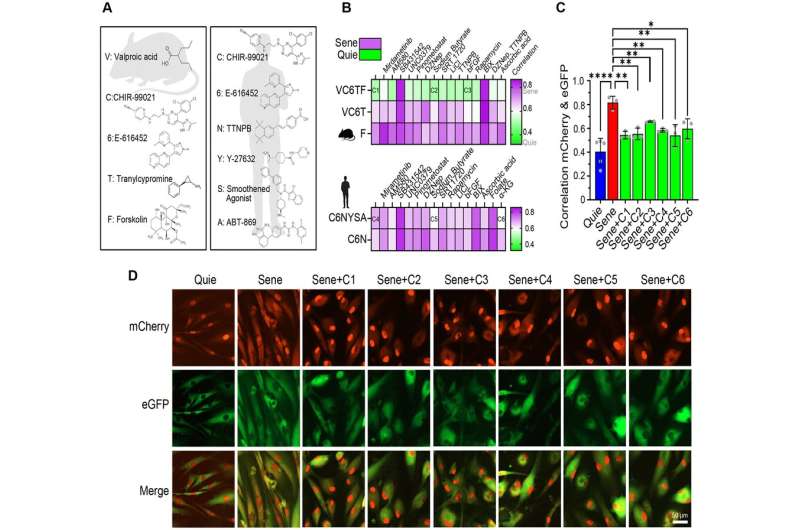Discovery of chemical means to reverse aging and restore cellular function
Originally published by Impact Journals LLC on July 13, 2023
Reprogramming small molecule cocktails restore NCC alterations in senescent cells. (A) Chemical structures of small molecules of basal cocktails used to generate induced pluripotent stem cells (iPSCs) from mouse (left) or human (right) somatic cells. (B) Correlation heatmaps showing eGFP and mCherry colocalization in human senescent fibroblasts demonstrate the effects of 80 different combinations of small molecules (n=2). (C, D) Validation of six selected cocktails through independent experiments, showing colocalization (C) and representative images (D) of eGFP and mCherry signals. Scale bar, 50 μm. Data are mean ± SD. *p < 0.05; **p < 0.01; ****p < 0.0001. One-way ANOVA-Bonferroni. Credit: Aging (2023). DOI: 10.18632/aging.204896
In a groundbreaking study, researchers have unlocked a new frontier in the fight against aging and age-related diseases. The study, conducted by a team of scientists at Harvard Medical School, has published the first chemical approach to reprogram cells to a younger state. Previously, this was only achievable using a powerful gene therapy.
On July 12, 2023, researchers from Harvard Medical School, University of Maine and Massachusetts Institute of Technology (MIT) published a new research paper in Aging, titled, "Chemically induced reprogramming to reverse cellular aging."
The team's findings build upon the discovery that the expression of specific genes, called Yamanaka factors, could convert adult cells into induced pluripotent stem cells (iPSCs). This Nobel Prize-winning discovery raised the question of whether it might be possible to reverse cellular aging without causing cells to become too young and turn cancerous.
In this new study, the researchers screened for molecules that could, in combination, reverse cellular aging and rejuvenate human cells. They developed high-throughput cell-based assays to distinguish young cells from old and senescent cells, including transcription-based aging clocks and a real-time nucleocytoplasmic protein compartmentalization (NCC) assay. In an exciting discovery, the team has identified six chemical cocktails that restore NCC and genome-wide transcript profiles to youthful states and reverse transcriptomic age in less than a week.
Read more
Comments
Post a Comment